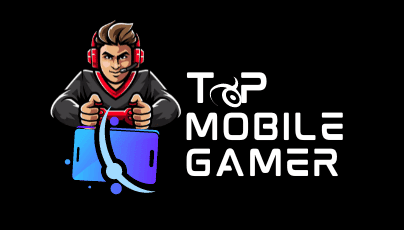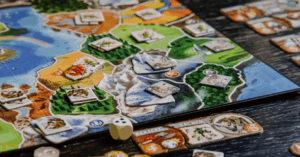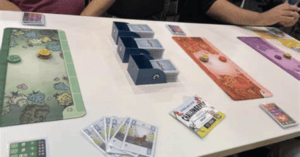Death Stranding is an intriguing experience that carries a strong story. It’s set in a world that seems near its end. Hideo Kojima and Kojima Productions crafted this game. It tells the tale of Sam Porter Bridges, a courier trying to bring the United Cities of America back together. He does this through delivering packages in an engaging way.
This story unfolds in a post-apocalyptic America. It’s filled with strange beings called BTs and a harmful rain, Timefall. Despite its slower pace, Death Stranding is all about the strength of connections between people. This message is wrapped in breathtaking sights, a world you can get lost in, and acted by known people like Norman Reedus and Troy Baker. It truly shifts how we see games.
Key Takeaways
- Death Stranding is a narrative-driven experience set in an apocalyptic world developed by Hideo Kojima and Kojima Productions.
- The game follows the journey of Sam Porter Bridges, a courier tasked with reconnecting the fractured United Cities of America through a delivery simulation gameplay loop.
- The game is set in a post-apocalyptic America overrun by BTs and ravaged by Timefall, a destructive phenomenon.
- Death Stranding features stunning visuals, an immersive soundscape, and a star-studded cast including Norman Reedus and Troy Baker.
- The game challenges traditional gaming conventions with its dense, complex, and slow-paced experience that focuses on the power of human connection.
The Haunting Post-Apocalyptic World of Death Stranding
Death Stranding is set in a post-apocalyptic United States. Here, the country is fractured and broken, with people living in scattered settlements. They face danger from the afterlife, where BTs roam the land.
America’s Fractured Landscape
In Death Stranding, a Post-Apocalyptic America is shown. It’s a fractured, desolate world now. Players explore mountains, plains, and forests in this Fractured Landscape.
The Threat of BTs and Timefall
The world is plagued by Timefall, damaging rain that ages everything it touches. In this deadly place, Sam aims to reunite isolated cities. He faces dangers like BTs lurking in every shadow.
Reconnecting the Chiral Network
Death Stranding focuses on rebuilding the country by reconnecting the Chiral Network. You play as Sam Bridges, a courier with a huge task. He must travel dangerous lands to bring help to isolated places.
Sam Bridges: The Courier on a Mission
Players enjoy a delivery simulation that’s quite engaging. They navigate tough areas with fragile cargo. There are dangers like BTs and Timefall. But, the mission is to unite broken cities and outposts.
Rebuilding America, One Delivery at a Time
By making deliveries, players strengthen connections among settlements. This leads to the gentle rebuilding of America. The game’s story is driven by the Chiral Network, showing progress as the country gets better.
Death Stranding Review: Gameplay and Mechanics
Death Stranding centers on a detailed cargo delivery simulation. You explore tough terrains and manage cargo while using many tools. These tools are crucial for delivering cargo safely. The traversal mechanics make players think carefully about each move, which adds lots of tension and fun.
The Art of Cargo Delivery Simulation
Cargo delivery simulation in Death Stranding is complex yet engaging. Players need to plan and carry out deliveries with care. They have to watch the cargo’s weight and pick the best paths. It’s all about making smart choices to get packages to their destination in one piece. This detailed style of play feels very satisfying when you get it right.
Balance and Stealth: Navigating the Treacherous Terrain
Stealth is a necessary skill in Death Stranding. You need to be sneaky to avoid enemies like BTs and MULEs. Balancing fast deliveries with stealth is key. This mix creates a unique experience compared to other open-world games. You always have to think about how to move forward without being caught.
Asynchronous Multiplayer: A Unique Online Experience
Death Stranding creates a new way to play online without direct encounters with others. The game lets players leave marks that impact everyone. This means you can help others and be helped without talking or seeing them.
Structures and Signs: Helping Fellow Porters
Players can build things like bridges and safe houses to help those playing too. These structures are key for everyone’s success. They make the game feel like everyone is working together.
Players also leave Signs to guide or cheer others on. This makes the world feel alive with the efforts of all players. It shows how much we need each other to succeed.
A Sense of Community in a Desolate World
Death Stranding’s multiplayer is special because it’s not about meeting others. It’s about feeling connected through everyone’s actions in the game. Even when you’re alone, you know others are with you in spirit.
This way of playing encourages helping each other for a shared goal. It’s more than just a game; it’s about a group effort that makes everyone’s journey better. It’s a unique and touching experience.
Death Stranding’s Stunning Visuals and Immersive Soundscape
Death Stranding shines as a visual and auditory masterpiece. It presents a post-apocalyptic setting that intrigues players. With its stunning visuals like rugged mountains and eerie forests, every detail feels real.
The game also boasts an amazing soundscape. A haunting musical score fills its environments with atmosphere. This tops off the experience, drawing players deeply into its world.
The Captivating Narrative and Compelling Characters
Death Stranding’s story, created by Hideo Kojima, is both deep and engaging. It explores themes like connection and the meaning of life. As the story unfolds, players face challenging ideas and twisty plots.
The game’s story is brought to life by its top-notch actors. Norman Reedus, Mads Mikkelsen, Léa Seydoux, and Troy Baker shine. Their performances draw you in, making the game’s world both immersive and real.
Hideo Kojima’s Unique Storytelling
Death Stranding‘s story stands out thanks to its amazing actors. Norman Reedus, Mads Mikkelsen, Léa Seydoux, and Troy Baker give it their all. Kojima’s plot mixed with their talent offers an unforgettable narrative.
A Star-Studded Cast
What makes Death Stranding’s story even better is its impressive cast. Norman Reedus, Mads Mikkelsen, Léa Seydoux, and Troy Baker stand out. Their roles add strong emotions and depth to the game’s story.
Death Stranding Review: A Masterpiece of Gaming
Death Stranding is a game that stands out as truly unique. It blends a strong story with a new multiplayer style and amazing sound and images. Though it’s not for everyone due to its slow nature, those who dive in find a story that really moves them.
This game is fruit of Hideo Kojima’s special vision and the hard work of the Kojima Productions team. It shows the great things games can do, making Death Stranding a masterpiece of gaming.
Challenges and Drawbacks
Death Stranding is truly a standout game. Yet, it comes with its share of hurdles and downsides. The game’s main focus on delivering goods, though rewarding, can get boring early on. This could be a turn-off, especially in the beginning.
Learning everything about moving around and managing balance also isn’t easy. It asks for a lot of patience and carefulness. Some might look for games that are quicker or more about action instead.
Moreover, the story might be hard for newcomers to Kojima’s style to get into. Understanding the deep themes and confusing story parts takes a lot of time and focus.
Conclusion
Death Stranding is a unique and captivating game. It changes how we see video games. It mixes great storytelling with gameplay that’s about delivering things. There are also cool multiplayer features that connect players.
The game is set in a world that’s been through a disaster. It’s not fast and easy to get into at first. But, for those open to its style, it’s a true work of art. This comes from Hideo Kojima and his team’s vision at Kojima Productions.
Death Stranding shows what games can do differently. It’s not easily forgotten. The end of the story brings to light the game’s unique qualities. It truly stands out and offers an experience like no other. This is why many call it a masterpiece.



















